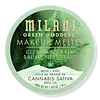What's inside
What's inside
 Key Ingredients
Key Ingredients

 Benefits
Benefits

 Concerns
Concerns

 Ingredients Side-by-side
Ingredients Side-by-side

Cetyl Ethylhexanoate
EmollientCaprylic/Capric Triglyceride
MaskingSorbeth-30 Tetraoleate
EmulsifyingPEG-5 Glyceryl Triisostearate
EmollientPEG-10 Isostearate
EmulsifyingPolyethylene
AbrasiveParfum
MaskingCamellia Sinensis Leaf Powder
ExfoliatingPhyllostachys Edulis Shoot Water
Skin ConditioningNelumbo Nucifera Flower Extract
Skin ConditioningCitrus Nobilis Peel Oil
MaskingWater
Skin ConditioningPhenoxyethanol
PreservativeSorbitan Sesquioleate
EmulsifyingPolyglyceryl-10 Oleate
Skin ConditioningButylene Glycol
HumectantLactic Acid
BufferingSodium Benzoate
MaskingCaprylyl Glycol
EmollientPotassium Sorbate
PreservativeEthylhexylglycerin
Skin ConditioningHexylene Glycol
EmulsifyingMaltodextrin
AbsorbentCI 19140
Cosmetic ColorantCI 42090
Cosmetic ColorantBamboo Vinegar
AntimicrobialCetyl Ethylhexanoate, Caprylic/Capric Triglyceride, Sorbeth-30 Tetraoleate, PEG-5 Glyceryl Triisostearate, PEG-10 Isostearate, Polyethylene, Parfum, Camellia Sinensis Leaf Powder, Phyllostachys Edulis Shoot Water, Nelumbo Nucifera Flower Extract, Citrus Nobilis Peel Oil, Water, Phenoxyethanol, Sorbitan Sesquioleate, Polyglyceryl-10 Oleate, Butylene Glycol, Lactic Acid, Sodium Benzoate, Caprylyl Glycol, Potassium Sorbate, Ethylhexylglycerin, Hexylene Glycol, Maltodextrin, CI 19140, CI 42090, Bamboo Vinegar
Ethylhexyl Palmitate
EmollientCarthamus Tinctorius Seed Oil
MaskingCaprylic/Capric Triglyceride
MaskingSorbeth-30 Tetraoleate
EmulsifyingPolyethylene
AbrasivePEG-5 Glyceryl Triisostearate
EmollientCannabis Sativa Seed Oil
EmollientParfum
MaskingDiisostearyl Malate
EmollientPhenoxyethanol
PreservativeTocopherol
AntioxidantSorbitan Sesquiisostearate
EmulsifyingButyrospermum Parkii Butter
Skin ConditioningSqualane
EmollientTriethoxycaprylylsilane
Aluminum Hydroxide
EmollientCI 42090
Cosmetic ColorantCI 19140
Cosmetic ColorantCI 77891
Cosmetic ColorantEthylhexyl Palmitate, Carthamus Tinctorius Seed Oil, Caprylic/Capric Triglyceride, Sorbeth-30 Tetraoleate, Polyethylene, PEG-5 Glyceryl Triisostearate, Cannabis Sativa Seed Oil, Parfum, Diisostearyl Malate, Phenoxyethanol, Tocopherol, Sorbitan Sesquiisostearate, Butyrospermum Parkii Butter, Squalane, Triethoxycaprylylsilane, Aluminum Hydroxide, CI 42090, CI 19140, CI 77891
 Reviews
Reviews

Ingredients Explained
These ingredients are found in both products.
Ingredients higher up in an ingredient list are typically present in a larger amount.
This ingredient is an emollient, solvent, and texture enhancer. It is considered a skin-softener by helping the skin prevent moisture loss.
It helps thicken a product's formula and makes it easier to spread by dissolving clumping compounds.
Caprylic Triglyceride is made by combining glycerin with coconut oil, forming a clear liquid.
While there is an assumption Caprylic Triglyceride can clog pores due to it being derived from coconut oil, there is no research supporting this.
Learn more about Caprylic/Capric TriglycerideCI 19140 is also known as Tartrazine. Tartrazine is a synthetic dye used in cosmetics, foods, and medicine to add a yellow color.
Tartrazine is created from petroleum and is water-soluble.
Some people may experience allergies from this dye, especially asthmatics and those with an aspirin intolerance.
Learn more about CI 19140Ci 42090 is a synthetic dye created from petroleum. It is used to give a bright blue color to cosmetics, medicine, and food.
Parfum is a catch-all term for an ingredient or more that is used to give a scent to products.
Also called "fragrance", this ingredient can be a blend of hundreds of chemicals or plant oils. This means every product with "fragrance" or "parfum" in the ingredients list is a different mixture.
For instance, Habanolide is a proprietary trade name for a specific aroma chemical. When used as a fragrance ingredient in cosmetics, most aroma chemicals fall under the broad labeling category of “FRAGRANCE” or “PARFUM” according to EU and US regulations.
The term 'parfum' or 'fragrance' is not regulated in many countries. In many cases, it is up to the brand to define this term.
For instance, many brands choose to label themselves as "fragrance-free" because they are not using synthetic fragrances. However, their products may still contain ingredients such as essential oils that are considered a fragrance by INCI standards.
One example is Calendula flower extract. Calendula is an essential oil that still imparts a scent or 'fragrance'.
Depending on the blend, the ingredients in the mixture can cause allergies and sensitivities on the skin. Some ingredients that are known EU allergens include linalool and citronellol.
Parfum can also be used to mask or cover an unpleasant scent.
The bottom line is: not all fragrances/parfum/ingredients are created equally. If you are worried about fragrances, we recommend taking a closer look at an ingredient. And of course, we always recommend speaking with a professional.
Learn more about ParfumPEG-5 Glyceryl Triisostearate isn't fungal acne safe.
Phenoxyethanol is a preservative that has germicide, antimicrobial, and aromatic properties. Studies show that phenoxyethanol can prevent microbial growth. By itself, it has a scent that is similar to that of a rose.
It's often used in formulations along with Caprylyl Glycol to preserve the shelf life of products.
Polyethylene is a synthetic ingredient that helps the skin retain moisture. It is a polymer.
It is also typically used within product formulations to help bind solid ingredients together and thicken oil-based ingredients. When added to balms and emulsions, it helps increase the melting point temperature.
Sorbeth-30 Tetraoleate is a surfactant and emulsifier.
This ingredient is a tetraester from oleic acid and polyethylene glycol ether of sorbitol.
As an emulsifier, it helps ingredients such as oil and water mix together. This allows the dirt and oils in your skin to be washed away.
One study found pumpkin oil containing Sorbeth-30 Tetraoleate helped hydrate the skin and did not cause any irritation.
Learn more about Sorbeth-30 Tetraoleate